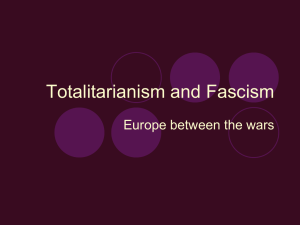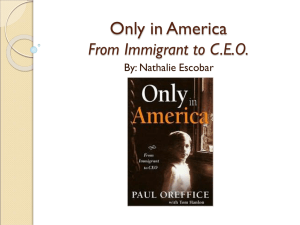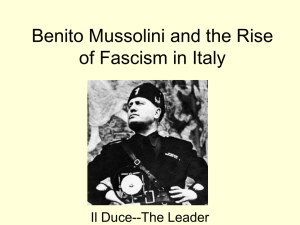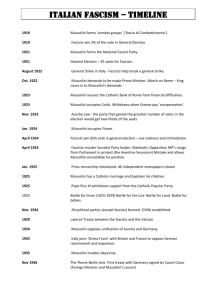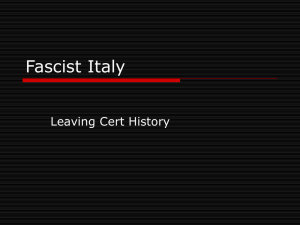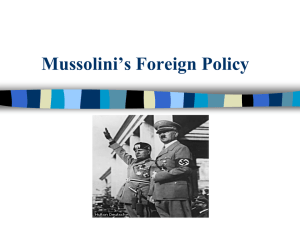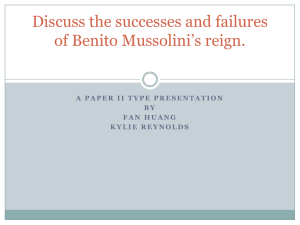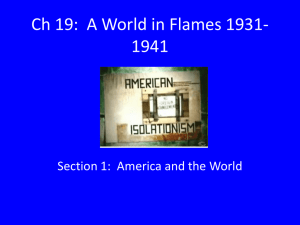17-3 Powerpoint - McCook Public Schools
advertisement
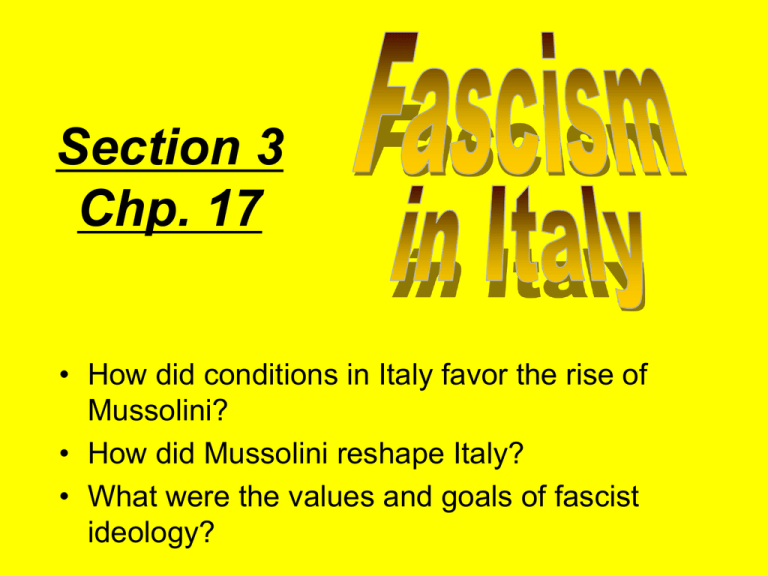
Section 3 Chp. 17 • How did conditions in Italy favor the rise of Mussolini? • How did Mussolini reshape Italy? • What were the values and goals of fascist ideology? Setting the Scene • “I hated politics and politicians,” said Italo Balbo. Like many Italian veterans of World War I , he had come home to a land of economic chaos and political corruption. Italy’s constitutional government, he felt “had betrayed the hopes of soldiers, reducing Italy to a shameful peace.” Disgusted and angry, Balbo rallied behind a fierce nationalist, Benito Mussolini •Mussolini’s rise to power in the 1920’s served as a model for ambitious strongmen elsewhere in Europe Rise of Mussolini • Italians were upset after the Peace of Paris, they had been promised land to join the allies and now that land became the country of Yugoslavia • Peasants seized land, workers went on strike or seized factories, the country was in chaos • Veterans had no jobs after defending their country at war • Trade declined and taxes rose • The government broke into factions, small groups, and was unable to come to any agreement on how to solve the problems. A Leader Emerges • Benito Mussolini who was the son of a socialist blacksmith and a teacher had been a socialist him self but rejected those beliefs for intense nationalism, he became the new voice of the Italians • He organized the Fascist party in 1919, made up of veterans and discontented citizens • Fascist comes from the Latin word fasces or a bundle of sticks wrapped around an ax, a symbol of authority in ancient Rome. •A fiery speaker he promised to end corruption and replace turmoil with order •Spoke of reviving Roman greatness pledging to turn the Mediterranean into a “Roman Lake” once again Seizing Power • Mussolini’s supporters were called Black Shirts they were organized into “combat squads” which broke up socialist rallies, smashed leftist presses, and attacked farmers’ cooperatives • By intimidation and terror these gangs ousted officials in Northern Italy • Most citizens accepted these thug groups because they had lost all faith in the government In 1922 at a rally in Naples the Fascists called for a “March on Rome” to demand changes, 10’s of thousands answered the call and King Victor Emmanuel III fearing Civil War asked Mussolini to form a new government Benito Mussolini becomes Prime Minister Without a shot fired Mussolini had achieved an appointment from the king and went around any constitution the country currently had Mussolini’s Italy • By 1925 Mussolini had taken the title of IL DUCE “the leader” – – – – He suppressed rival political parties Censored the press Rigged Elections Replaced elected officials with Fascists Italy supposedly remained a constitutional monarchy but it was really a dictatorship controlled by terror Critics were thrown in jail, forced into exile, or even murdered Secret police and propaganda strengthened the hold Mussolini had on Italy Mussolini’s Italy POLITICAL STRUCTURE ECONOMIC POLICY By 1925, Mussolini had assumed the title Il Duce, “The Leader.” Mussolini brought the economy under state control. In theory, Italy remained a parliamentary monarchy. In fact, it became a dictatorship upheld by terror. Unlike socialists, Mussolini preserved capitalism. The Fascists relied on secret police and propaganda. Workers received poor wages and were forbidden to strike. SOCIAL POLICIES The individual was unimportant except as a member of the state. Men were urged to be ruthless warriors. Women were called on to produce more children. Fascist youth groups toughened children and taught them to obey strict military discipline. What Is Fascism? In the 1920s and 1930s, fascism meant different things in different countries. All forms of fascism, however, shared some basic features: • extreme nationalism • glorification of action, violence, discipline, and, above all, blind loyalty to the state • rejection of Enlightenment faith in reason and the concepts of equality and liberty • rejection of democratic ideas – Believed democracy led to corruption and weakness – Emphasized emotion and the need to the citizen to serve the state • pursuit of aggressive foreign expansion • glorification of warfare as a necessary and noble struggle for survival Compared to Communism • Fascists were sworn enemies of socialists and communists • Communists wanted internal changes, Fascists wanted more land and a stronger homeland • Communists were supported by the working class and poor Fascists by the rich and middle class • Similarities between the two groups were the idea of new social programs, Dictators imposed totalitarian governments, and in both the leaders claimed to rule out of national interests Totalitarian Rule • Italy was the first Totalitarian state, which became a model for other states, even though rule by Mussolini was not as absolute or as brutal as by Stalin in the USSR and Hitler in Germany •There were 6 basic features of totalitarian rule •Single party dictatorship •State control of economy •Use of police spies and terror to enforce rules •Strict censorship of media •Use of schools and media to indoctrinate and mobilize citizens •Unquestioning obedience to a single leader Appeal • Why did FASCISM appeal to Italians? – – – – It promised a strong, stable government An end to political feuding Revival of National pride Mussolini showed power and confidence in a time of disorder and despair • At first IL DUCE was respected by foreign countries “he got the trains running of time” made chaos into an ordered, disciplined society • After Mussolini started to call for military action, and the increasing of the size of Italy, world powers saw Mussolini for what he was!!!! Looking Ahead • After World War I three systems of government competed for influence in Europe – Democracy like in Britain and France – Communism in Russia – Fascism in Italy • Fascism with its chest-pumping calls for action, national unity, and dedication to the state ignited patriotic feelings, as the Great Depression spread other nations looked to leaders that preached fascism
